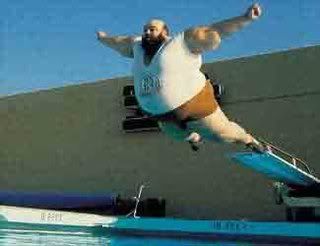Chapter 3 is an informative chapter about the meaning and use of 'closure' within comics. It is interesting to see how our minds actually work, when we see lots of images, it is amazing how we can bring those images together in our head and work out a story.
[Image taken from GoogleImages "bellyflop"]
The image is an example of how closure works. The fat man is diving off a diving board, yet we do not see how he lands, the viewers mind creates closure as they imagine the landing of the man in the water. Closure is helpful because our minds can finish off what happens more imaginative and thus funnier then watching what really happens.
The role of 'gutters' was also outlined within this chapter. Gutters are the space in between panels. I like how there are several distinct categories of panel-to-panel transitions, and how they can be all used in one comic (though rarely are) and done in such a way that readers are able to easily read through and enjoy the story. I appreciate the strategic element of it. Its amazing how certain scenes may be left out but because of our own minds we fill in the gaps and still manage to enjoy comics. This is a new concept to me and reminds me of the role of in-betweeners in animation. The difference is, we are the in-betweeners, and our minds determine how one panel relates to the following one. In betweeners draw all images from subject to subject so that the animation moves along smoothly. In a comic, the story line moves along thanks to the help of our own heads.

[This incredible graphic was created by me in photoshop]
The above image is just a quick example of the use of gutters. The gutter in between panels is where the viewers mind assumes what happened from the first panel to the second one.


No comments:
Post a Comment